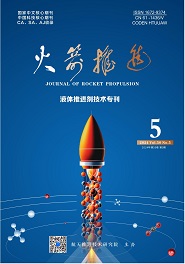航天推进技术研究院主办
ZHAO Yang,DENG Yongfeng,WEI Jianguo,et al.Experimental study on vacuum micro-arc thruster and on-orbit test[J].Journal of Rocket Propulsion,2022,48(04):88-96.
真空微弧推进系统试验及在轨测试
- Title:
- Experimental study on vacuum micro-arc thruster and on-orbit test
- 文章编号:
- 1672-9374(2022)04-0088-09
- Keywords:
- microsatellite vacuum micro-arc propulsion magnetic field on-orbit verification thrust test
- 分类号:
- V439
- 文献标志码:
- A
- 摘要:
- 目前全球微小卫星呈爆发式增长态势,市场潜力巨大,针对可应用于微小卫星的推进系统顺势成为了全球的研究热点。介绍了可应用于微小卫星的电推进系统——真空微弧推进系统,首先概述了真空微弧推进系统的参数及结构特点,对该推进系统的工作原理和系统组成进行了研究分析,采用无触发式点火技术及石墨涂层工艺成功将真空起弧功率降至10 W以内,利用磁场控制电弧旋转的技术使阴极实现均匀烧蚀,并研制探针对磁场控制电弧效果进行测试,利用扭摆式测量系统完成微牛级推力测量,获取不同频率(6~20 Hz)、不同起弧电流(50~80 A)工况下的推力变化趋势。目前,真空微弧推进系统工程样机已成功开展在轨验证并完成在轨的推力测试,同时详细阐述了样机在轨测试的方法及推力标定方法,该方法为“海创千乘”卫星平台首次提出,对后续卫星平台微推力标定具有重要的研究意义。
- Abstract:
- The number of microsatellites shows an explosive growth with huge market potential, and the propulsion system of microsatellites has become a global research hotspot.This paper introduces a vacuum micro-arc propulsion system, which can be applied to micro satellites.Firstly,the parameters and structural characteristics of the vacuum micro-arc propulsion system were outlined.Secondly, the methods of triggerless discharge and uniform ablation were studied in detail, and the magnetic field was simulated and analyzed.Low-cost graphite coating process was used to reduce arc striking energy to less than 10 W.The trust test was completed by using torsional system and the thrust variation was obtained with the changing of frequency and current.Finally, the experimental research of the vacuum micro-arc propulsion system was studied in detail.At present, the vacuum arc propulsion system has successfully completed the on-orbit work and the thrust test.
参考文献/References:
[1] 王尚民,田立成,张家良,等.微脉冲等离子体推力器放电过程和性能初探[J].中国空间科学技术,2017,37(5):24-32.
[2] 郭登帅,康小明,刘欣宇,等.场发射电推力器的研究现状及其关键技术[J].火箭推进,2018,44(4):1-9.
GUO D S,KANG X M,LIU X Y,et al.Research status and key technologies of field emission electric propulsion thruster[J].Journal of Rocket Propulsion,2018,44(4):1-9.
[3] 张天平,耿海,张雪儿,等.离子电推进技术的发展现状与未来[J].上海航天,2019,36(6):88-96.
[4] 杨振宇,赵杨,李光熙,等.1 mN射频离子推力器参数与性能分析[J].火箭推进,2020,46(3):75-82.
YANG Z Y,ZHAO Y,LI G X,et al.Parameters and performance analysis of 1 mN RF ion thruster[J].Journal of Rocket Propulsion,2020,46(3):75-82.
[5] ZHUANG T S,SHASHURIN A,BEILIS I,et al.Ion velocities in a micro-cathode arc thruster[J].Physics of Plasmas,2012,19(6):063501.
[6] KEIDAR M,HAQUE S,ZHUANG T,et al.Micro-cathode arc thruster for phonesat propulsion[C]//27th Annual AIAA/USU Conference on small satellites.Reston,Virginia:AIAA,2013.
[7] HURLEY S,TEEL G,LUKAS J,et al.Thruster subsystem for the United States naval academys(USNA)ballistically reinforced communication satellite(BRICSat-P)[J].Transactions of the Japan Society for Aeronautical and Space Sciences,Aerospace Technology Japan,2016,14(30):157- 163.
[8] JI T Y,WEI L Q,WANG Y F,et al.Influence of pulse frequency on discharge characteristics of micro-cathode arc thruster[J].Vacuum,2022,196:110748.
[9] KEIDAR M,ZHUANG T S,SHASHURIN A,et al.Electric propulsion for small satellites[J].Plasma Physics and Controlled Fusion,2015,57(1):014005.
[10] ZHUANG T S,SHASHURIN A,DENZ T,et al.Performance characteristics of micro-cathode arc thruster[J].Journal of Propulsion and Power,2013,30(1):29-34.
[11] KEIDAR M,SCHEIN J,WILSON K,et al.Magnetically enhanced vacuum arc thruster[J].Plasma Sources Science and Technology,2005,14(4):661-669.
[12] ANDERS A,BROWN I G,MACGILL R A,et al.‘Triggerless triggering of vacuum arcs[J].Journal of Physics D:Applied Physics,1998,31(5):584-587.
[13] ANDERS A,SCHEIN J,QI N.Pulsed vacuum-arc ion source operated with a “triggerless” arc initiation method[J].Review of Scientific Instruments,2000,71(2):827-829.
[14] 刘万龙,王得志,刘硕,等.几种国外火箭发动机推力矢量测量装置概述[J].火箭推进,2021,47(4):6-12.
LIU W L,WANG D Z,LIU S,et al.Several foreign rocket engine thrust vector measuring devices[J].Journal of Rocket Propulsion,2021,47(4):6-12.
备注/Memo
收稿日期:2022-02-09 修回日期:2022-03-28
基金项目:国家自然科学基金(11475131) 航天科技集团钱学森青年创新基金项目
作者简介:赵杨(1987—),女,硕士,高级工程师,研究领域为电推进技术。
